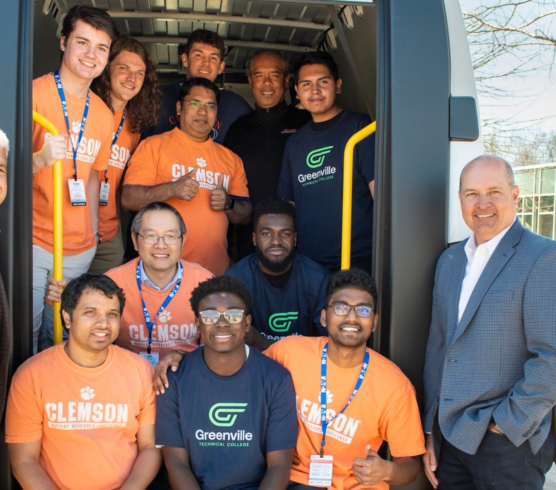Bill Gallagher, the President of Solar-Fit and host of the Solar-Fit Renewable Energy Show, interviewed the team lead of the EcoEagles, the team taking part in the EcoCAR 2 Competition at Embry-Riddle Aeronautical University (ERAU). Chester Rowe II is the team lead for the EcoEagles and a Masters student at ERAU. Listeners as far as Czechoslovakia listened to the broadcast about ERAU’s EcoEagles.
The host, Gallagher, told the team he “really want to get into the nuts and bolts of this thing.” Rowe went on to explain that the 15 schools in the EcoCAR 2 competition are given a 2013 Chevrolet Malibu to modify. They are responsible for removing the powertrain and any other parts that won’t be used and replacing them with custom-made parts. Last semester, students – some of which had never disassembled a vehicle – worked together to remove the powertrain in only a week’s time.
The EcoEagles’ car has a Series Plug-in Hybrid Electric Vehicle (PHEV) architecture. The car uses electricity and B20 biodiesel – 20% processed vegetable oil, 80% diesel fuel. However, the throttle has no direct link to the diesel engine; the B20 biodiesel is only used to power a generator within the vehicle. And as long as the car is driven within the 35 to 40-mile range of the battery pack, there is no need to use the biodiesel, which means zero emissions.
“It’s really amazing how much technology is going into this battery pack,” said Rowe. The battery pack is just under 300 volts and each pack has its own circuit board. By looking at the controls, we can tell the voltage of each cell in the six modules. He goes on to say that it was humorous to watch how excited the students were to cut the hole in the trunk – after removing the gas tank, of course – to install the battery pack. A 220-volt car will charge in about 5 hours when using a standard charger.
Although many believe that a gasoline-powered engine will always outperform an electric motor, an electric motor of comparable size actually has more torque than an internal combustion engine. An electric motor’s initial acceleration is greater than an internal combustion engine. The top speed will be about 80 mph, which is more than enough for everyday use.
Not having an internal combustion engine causes some unexpected problems. A main issue was air conditioning, which is usually belt-driven from the internal combustion engine. To prevent any possible problem, GM donated an electric compressor to ERAU to make sure there is always air conditioning in the car.
The lack of an alternator also poses a problem. Many electric cars today still have a low-voltage system that is charged by an alternator. In our design, there is no alternator at all; instead, we use an auxiliary power module, or APM, that takes the 300-volt battery charge and converts it to a lower voltage to charge the system for us.
Solar-Fit was able to attend the Board of Visitor’s meeting at ERAU a few days before and took a tour of the Green Garage. Gallagher was fascinated by the engineering capabilities of the school and the extent of the operations done by the students in the green garage.
Rowe broke down the organization of the EcoCAR 2 team, describing each sub-team and their responsibilities. He emphasized that the purpose of participating in the EcoCAR 2 competition is “not only to build an awesome car, but also to provide a learning experience for the students.”
“It’s really amazing what this team has done,” remarked Rowe. He further stated that there are great faculty advisors and bright and dedicated students working on this project.
In addition to talking about EcoCAR 2, Rowe gave an overview of the different tracks of the Mechanical Engineering program, the Baja team, and the SAE Formula Hybrid competition.
When Gallagher concluded the show, he had one thing to say: “This is our future, folks.”



